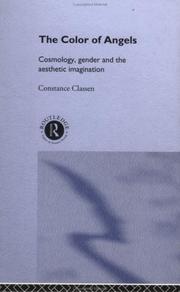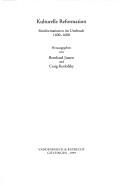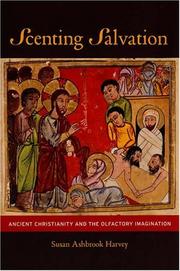| Listing 1 - 8 of 8 |
Sort by
|
Book
ISBN: 9780754666424 9781409424468 0754666425 1409424464 9781315553016 131701636X 1315553015 1317016351 1283015528 9786613015525 9781317016342 9781317016359 9781283015523 9781317016366 1317016343 Year: 2016 Publisher: London ; New York : Routledge,
Abstract | Keywords | Export | Availability | Bookmark
 Loading...
Loading...Choose an application
- Reference Manager
- EndNote
- RefWorks (Direct export to RefWorks)
Challenging the assumption that medieval Catholicism was overly sensual, whilst Protestantism rejected any element of worship appealing to the eye, ear, or nose, this study asks fundamental questions about the relationship between religion and the senses. The book begins with an examination of pre-Reformation beliefs and practices, establishing intellectual views on the senses in fifteenth-century England. Having established the parameters for the role of sense before the Reformation, the second half of the book mirrors these concerns in the post-1520 world, looking at how, and to what degree,
Christian church history --- anno 1500-1599 --- Great Britain --- Reformation --- Senses and sensation --- Worship --- Religious aspects --- Christianity --- History. --- England --- Church history. --- England -- Church history. --- Reformation -- England. --- Senses and sensation -- Religious aspects -- Christianity -- History. --- Senses and sensation --Religious aspects --Christianity. --History. --- Worship -- History. --- Religion --- Philosophy & Religion --- History --- Sensation --- Sensory biology --- Sensory systems --- Knowledge, Theory of --- Neurophysiology --- Psychophysiology --- Perception --- English Reformation --- Religious aspects&delete& --- Christianity&delete& --- E-books

ISBN: 0415180740 0415180732 9780415180740 Year: 1998 Publisher: London: Routledge,
Abstract | Keywords | Export | Availability | Bookmark
 Loading...
Loading...Choose an application
- Reference Manager
- EndNote
- RefWorks (Direct export to RefWorks)
Senses and sensation in art --- Philosophy of nature --- Sociology of the family. Sociology of sexuality --- Aesthetics of art --- Senses and sensation --- Sex differences --- History --- Religious aspects --- Christianity --- History. --- Senses and sensation - Sex differences - History. --- Senses and sensation - Religious aspects - Christianity - History. --- Senses and sensation in art - History. --- Sensation --- Sensory biology --- Sensory systems --- Religious aspects&delete& --- Christianity&delete& --- Sex differences&delete& --- Knowledge, Theory of --- Neurophysiology --- Psychophysiology --- Perception --- Senses and sensation - Sex differences - History --- Senses and sensation - Religious aspects - Christianity - History --- Senses and sensation in art - History

ISBN: 9783525354605 3525354606 Year: 1999 Volume: 145 Publisher: Göttingen: Vandenhoeck und Ruprecht,
Abstract | Keywords | Export | Availability | Bookmark
 Loading...
Loading...Choose an application
- Reference Manager
- EndNote
- RefWorks (Direct export to RefWorks)
Reformation --- Senses and sensation --- Réforme (Christianisme) --- Sens et sensations --- Religious aspects --- Christianity --- History. --- Aspect religieux --- Christianisme --- Histoire --- 930.85.44 --- Cultuurgeschiedenis: Renaissance --- 930.85.44 Cultuurgeschiedenis: Renaissance --- Réforme (Christianisme) --- Sensation --- Sensory biology --- Sensory systems --- Knowledge, Theory of --- Neurophysiology --- Psychophysiology --- Perception --- Religious aspects&delete& --- Christianity&delete& --- History --- Reformation - Germany. --- Senses and sensation - Religious aspects - Christianity - History.
Book
ISBN: 9788873671145 8873671144 Year: 2010 Volume: 153 Publisher: Roma: CLV,
Abstract | Keywords | Export | Availability | Bookmark
 Loading...
Loading...Choose an application
- Reference Manager
- EndNote
- RefWorks (Direct export to RefWorks)
Senses and sensation --- Liturgics --- Religious aspects --- Christianity --- History --- 264 <09> --- Liturgie--Geschiedenis van ... --- 264 <09> Liturgie--Geschiedenis van ... --- Sensation --- Sensory biology --- Sensory systems --- Knowledge, Theory of --- Neurophysiology --- Psychophysiology --- Perception --- Religious aspects&delete& --- Christianity&delete& --- Liturgie--Geschiedenis van .. --- Liturgie--Geschiedenis van . --- Liturgie--Geschiedenis van --- Senses and sensation - Religious aspects - Christianity - History --- Liturgics - History
Book
ISBN: 9780271083452 027108345X 0271085207 Year: 2019 Publisher: Pennsylvania (PA): Pennsylvania state university press,
Abstract | Keywords | Export | Availability | Bookmark
 Loading...
Loading...Choose an application
- Reference Manager
- EndNote
- RefWorks (Direct export to RefWorks)
"Explores how the distinctive formal and material qualities of a range of Romanesque sculpture types stimulated multisensory religious experiences. Emphasizes the power of these sculptures to "come alive" in ritual and produce emotional responses for Christians of the time"--
Sculpture, Romanesque. --- Human body --- Senses and sensation --- Christianity and art. --- Religious aspects --- Christianity --- History --- Relief (Sculpture), Romanesque --- Christian art and symbolism --- Sculpture, Romanesque --- Christianity and art --- Human body - Religious aspects - Christianity - History - To 1500 --- Senses and sensation - Religious aspects - Christianity - History - To 1500
Book
ISBN: 9789004236349 9789004236653 9004236341 9004236651 1283854465 Year: 2013 Volume: 26 Publisher: Leiden ;Boston Brill
Abstract | Keywords | Export | Availability | Bookmark
 Loading...
Loading...Choose an application
- Reference Manager
- EndNote
- RefWorks (Direct export to RefWorks)
Sensation is the subject of a burgeoning field in the humanities. This volume examines its role in the religious changes and transformations of early modern Europe. Sensation was not only central to the doctrinal disputes of the Reformation, but also critical in shaping new or reformed devotional practices. From this vantage point the book explores the intersections between the world of religion and the spheres of art, music, and literature; food and smell; sacred things and spaces; ritual and community; science and medicine. Deployed in varying, often contested ways, the senses were essential pathways to the sacred. They permitted knowledge of the divine and the universe, triggered affective responses, shaped holy environments, and served to heal, guide, or discipline body and soul. Contributors include Alfred Acres, Barbara Baert, Andrew R. Casper, Wietse de Boer, Sven Dupré, Iain Fenlon, Laura Giannetti, Christine Göttler, Jennifer R. Hammerschmidt, Joseph Imorde, Rachel King, Jennifer Rae McDermott, Walter S. Melion, Matthew Milner, Sarah Joan Moran, Yvonne Petry, and Klaus Pietschmann.
Christian church history --- emotion --- Art --- anno 1600-1699 --- anno 1500-1599 --- Europe --- Senses and sensation --- Senses and sensation in art --- Sens et sensations --- Sens et sensations dans l'art --- Religious aspects --- Christianity --- History. --- Aspect religieux --- Christianisme --- Histoire --- History --- Sensation --- Sensory biology --- Sensory systems --- Knowledge, Theory of --- Neurophysiology --- Psychophysiology --- Perception --- Religious aspects&delete& --- Christianity&delete& --- Senses and sensation - Religious aspects - Christianity - History --- Senses and sensation in art - History --- Senses and sensation - Europe - History --- religious experience

ISBN: 9780520241473 0520241479 Year: 2006 Volume: 42 Publisher: Berkeley: University of California press,
Abstract | Keywords | Export | Availability | Bookmark
 Loading...
Loading...Choose an application
- Reference Manager
- EndNote
- RefWorks (Direct export to RefWorks)
This book explores the role of bodily, sensory experience in early Christianity (first - seventh centuries AD) by focusing on the importance of smell in ancient Mediterranean culture. Following its legalization in the fourth century Roman Empire, Christianity cultivated a dramatically flourishing devotional piety, in which the bodily senses were utilized as crucial instruments of human-divine interaction. Rich olfactory practices developed as part of this shift, with lavish uses of incense, holy oils, and other sacred scents. At the same time, Christians showed profound interest in what smells could mean. How could the experience of smell be construed in revelatory terms? What specifically could it convey? How and what could be known through smell? Scenting Salvation argues that ancient Christians used olfactory experience for purposes of a distinctive religious epistemology: formulating knowledge of the divine in order to yield, in turn, a particular human identity. Using a wide array of Pagan, Jewish, and Christian sources, Susan Ashbrook Harvey examines the ancient understanding of smell through religious rituals, liturgical practices, mystagogical commentaries, literary imagery, homiletic conventions; scientific, medical, and cosmological models; ascetic disciplines, theological discourse, and eschatological expectations. In the process, she argues for a richer appreciation of ancient notions of embodiment, and of the roles the body might serve in religion.
Smell --- Senses and sensation --- Odors. --- Worship. --- Sacrifice. --- Religious aspects --- Christianity --- History. --- Odorat --- Sens et sensations --- Odeurs --- Cultes --- Sacrifice --- Aspect religieux --- Christianisme --- Histoire --- Odors --- Worship --- Cult --- Cultus --- Religion --- Theology, Practical --- Fire-worshipers --- Olfaction --- Chemical senses --- Nose --- Burnt offering --- Sensation --- Sensory biology --- Sensory systems --- Knowledge, Theory of --- Neurophysiology --- Psychophysiology --- Perception --- Aromas --- Fragrances --- Scents --- Smells --- Sensory evaluation --- Religious aspects&delete& --- Christianity&delete& --- History --- Odours --- Smell - Religious aspects - Christianity - History. --- Senses and sensation - Religious aspects - Christianity - History.
Book
ISBN: 9782503530994 2503530990 Year: 2009 Volume: 7 Publisher: Turnhout: Brepols,
Abstract | Keywords | Export | Availability | Bookmark
 Loading...
Loading...Choose an application
- Reference Manager
- EndNote
- RefWorks (Direct export to RefWorks)
Que peut-on vraiment lire dans les récits médiévaux relatant les émanations et les perceptions des ‘odeurs de sainteté’? Cette expression elle-même fut-elle jamais pleinement signifiante, non pas sublimée en une métaphore toute spirituelle, mais au contraire bien charnelle, et donc partie intégrante d’une culture ? Prenant pour point de départ les récits d’exhalaisons extraordinaires, cet ouvrage s’attache à reconstruire l’importance et la signification qu’ont pu revêtir odeurs et odorat en Europe occidentale, dans la culture et la pensée religieuses, voire même dans l’expérience des hommes et des femmes du haut Moyen Âge, période formatrice s’il en fut. S’appuyant sur un dépouillement systématique des récits hagiographiques, Martin Roch revalorise ces sources, souvent décriées, tout en les confrontant méticuleusement aux textes bibliques et patristiques, aux documents liturgiques, et même aux données archéologiques disponibles. En déplaçant le point de vue de l’odeur miraculeuse à sa perception et aux récits qui en sont faits, l’auteur se tient fermement sur le terrain de l’histoire, de ses sources et de ses méthodes, sans se priver pour autant de dialoguer avec les autres sciences humaines, ou encore la médecine, ou la psychologie. Il démontre ainsi que, par delà les formules littéraires, les approches superficiellement rationalistes ou les effets de mode, les odeurs extraordinaires peuvent être reconnues comme un authentique objet d’histoire.
Philosophy and psychology of culture --- anno 500-799 --- Aromas --- Beschaving [Middeleeuwse ] --- Civilisation médiévale --- Civilization [Medieval ] --- Civilization [Medieval ]--History --- Europa--Beschaving--476-1492 --- Europe--Civilisation--476-1492 --- Europe--Civilization--476-1492 --- Fragrances --- Geuren --- Medieval civilization --- Middeleeuwen--Beschaving --- Middeleeuwen--Cultuur --- Middeleeuwse beschaving --- Middeleeuwse cultuur --- Middle Ages--Civilization --- Moyen-Age--Civilisation --- Odeuren --- Odeurs --- Odors --- Scents --- Substances odorantes --- Smell --- Senses and sensation --- Civilization, Medieval --- Odorat --- Sens et sensations --- Religious aspects --- Christianity --- Social aspects --- History --- Aspect religieux --- Christianisme --- Aspect social --- Histoire --- Civilization, Medieval. --- Odors. --- 235.3*19 --- Hagiografie: varia --- 235.3*19 Hagiografie: varia --- Civilisation médiévale --- Sensation --- Sensory biology --- Sensory systems --- Knowledge, Theory of --- Neurophysiology --- Psychophysiology --- Perception --- Smells --- Sensory evaluation --- Middle Ages --- Civilization --- Chivalry --- Renaissance --- Olfaction --- Chemical senses --- Nose --- To 1500 --- Odours --- Smell - Religious aspects - Christianity - History - To 1500 --- Smell - Social aspects - History - To 1500 --- Senses and sensation - Religious aspects - Christianity - History - To 1500 --- Senses and sensation - Social aspects - History - To 1500 --- Odeur de sainteté --- Moyen âge
| Listing 1 - 8 of 8 |
Sort by
|

 Search
Search Feedback
Feedback About UniCat
About UniCat  Help
Help News
News